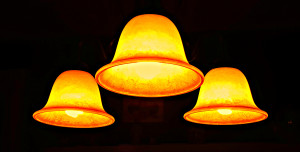Lights
No, you don’t have to live by candlelight, kerosene lantern or flashlight, you can save those for the romantic evening.
This is what we found when looking at lights
-12 volt lights. Like those that are used in travel trailers
-Gas lighting. Yep, it's still out there and there are some really nice gas fixtures, however, these may not be allowed by your local building department.
-Kerosene lights. I'm not talking about the kind you buy at Walmart. Wow- if you look at some of the antiques, there are some gorgeous fixtures. I had never seen the likes of these!
- Candles
Not a very good choice as a primary light source for a variety of reasons. Great for ambience though.
- Normal everyday lights
You know- the kind you grew up with. I'm talking about the regular old light fixtures that you turn on from a wall switch. We went with the old fashioned normal light fixture. We converted them to compact fluorescent and that helped a lot. Since then, LED’s have been gaining popularity and have been slowly coming down in price. LED bulbs use a fraction of the power of any other light source. In the end this was the simplest and easiest way.
You can certainly use any of the other methods available but for a home that most would want to buy later on down the road if we ever decided to sell, this seemed the best choice.
Refrigerator
We all need one - the question is how big and which is best? What is the size that you are currently using and is it adequate? Could you use a smaller one? Are you willing to pay big money for one of the super insulated – super efficient models? ($2500 - $3500) What about a gas fridge? They have actually been around for decades and are still available – again they can be somewhat pricey ($1800 - $2500). How about the kind that are used in travel trailers, they work on 120 volt, propane or 12 volt (pretty cool huh?) also really pricey if you want to get anywhere near the size of a regular fridge ($1000 - $1300) apiece for a new one. Usually those who want the capacity get 2 of them with opposing doors and make them like a side by side fridge. This can run as high as $2500.00 to as high as $3000.000 for 2 good size new units. You could try to find used ones if you wanted to go this route.
We talked with one company who suggested just adding a little more to our solar array, and stick with a regular fridge. We decided that we had enough solar based on the size of our fridge and the power it consumes. Ours is an 18.2 cubic foot and is adequate for our needs and our system is just big enough to handle it. Should this ever wear out it will be much simpler and less expensive to find a replacement. Since we installed our system, 'Energy Star' compliant appliances have become readily available. I measured the wall thickness of an energy star rated fridge; the fridge had 50% more insulation and the freezer had double the amount of insulation than the old ones. When our current one wears out, I plan on getting one of these, the same size that we have now.
Kitchen Stove
Things get a little interesting here. I had to do quite a bit of research which ended up being pretty frustrating. Here’s the problem:
Electric stoves are right up there with electric clothes dryers as power eaters.
So what’s the logical option – GAS!
That’s right but it’s not quite as simple as you might think. In my research this is what I found; there are 3 different systems to get the oven burner going.
1. A “glow plug” type that is electronically controlled.
2. A standing pilot.
3. A flame sensor (or thermocouple) type with a “Piezo” igniter to get the pilot going.
The Piezo type is what we have and it took some real time to find it. I wanted a stove that had no “standing pilot” and no other electronics or electrical components – not even a clock or oven light.
I called all of the usual stores and talked with everyone I could but to no avail. It seemed that there were simply no gas stoves that fit the bill. Well, I couldn’t accept that and wouldn’t give up and yes finally - I did find one range that would work. It’s a “Premier” Pro Series 6 burner and it does utilize a piezo type ignition for the oven pilot. What happens is this; when you turn the oven knob on, a small portion of gas is sent to a pilot and the igniter lights this pilot. After the pilot is lit it acts like a regular gas range in that, it heats up a thermocouple which in turn allows the gas valve to open and send gas to the main burner. The pilot will stay lit until you turn the knob off. When you do turn the knob off, even the pilot goes out completely so no wasted gas. These were all of the features that I was looking for and the only stove I could find that fit the bill. I have included their website below if you are interested.
I don’t know how much newer stoves have changed to be “off grid friendly” but if you are serious about living the off grid life I would strongly encourage you to look before you leap when it comes to a kitchen range. Don’t assume anything and if you have any doubts when talking to sales people, get the manufacturers phone number and call them directly with your questions.
Next up: "Staying Warm"
